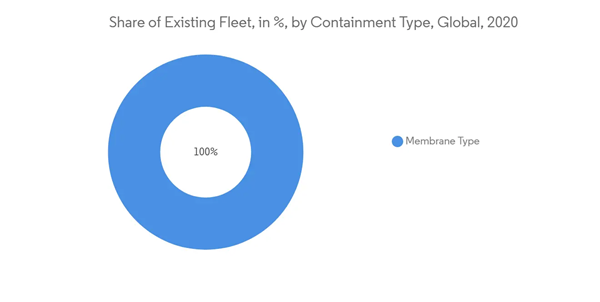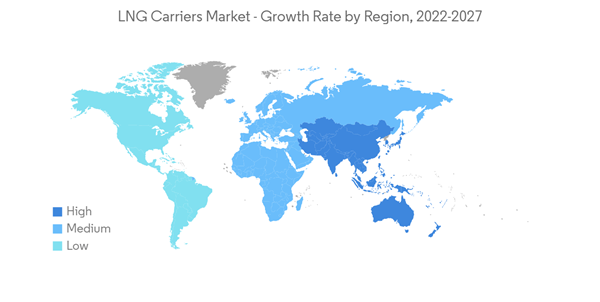The LNG carrier market is expected to record a CAGR of approximately 3.6% during the forecast period. The COVID-19 pandemic has hindered the market's growth as the demand for gas declined in the first half of 2020. The International Energy Agency (IEA) reported that gas consumption declined by 4% in 2020. Also, as per Oxford Energy, gas consumption in Europe declined by about 8% Y-o-Y in the first five months of 2020. Factors such as flexible deployment capabilities, increased efficiency, and increasing global consumption of LNG driven by supportive government regulations and demand from several end-user industries, including power generation and industrial, are expected to drive the market in the coming years. However, with the new carrier fleet entering the market and with regional shipping imbalances, there has been a fluctuation in the charter rates of carriers, which may hinder the market’s growth during the forecast period.
This product will be delivered within 2 business days.
Key Highlights
- Membrane type containment was the largest segment of the global LNG carrier market as of 2020, owing to its higher carrying capacity and increased visibility. This segment is expected to continue dominating the market during the forecast period.
- Many terminals are adjusting to accommodate small-scale and bunkering vessels to comply with emissions targets and capture new commercial opportunities. Conventional oil-based fuels will remain the main fuel option for most vessels in the future. At the same time, commercial opportunities of LNG are much interesting for many projects.
- Asia-Pacific is expected to dominate the market, with most of the demand coming from China, Japan, and India.
LNG Carriers Market Trends
Membrane Type Containment to Dominate the Market
- The membrane-type segment held the largest market share in 2020, accounting for around 79%, owing to its higher carrying capacity and other advantages. This containment segment is expected to dominate the global market throughout the forecast period.
- Gaztransport and Technigaz (GTT) designed the most common membrane tank systems. Several GTT systems have already been implemented onboard LNG carriers for many years, and other designs from different companies have been developed.
- By 2020, 454 units of the active fleet had a GTT membrane-type containment system. It continues to lead the order book as the preferred containment option.
- Due to technological advancements, the membrane-type containment has a superior capacity to bear the immense pressure of LNG and its compact shape to carry large LNG volumes compared to moss-type containment.
- Therefore, with the largest market share and existing fleet by containment type (active), the membrane-type LNG carrier’s demand is expected to grow significantly over the forecast period.
Asia-Pacific to Dominate the Market
- Asia-Pacific accounted for the largest LNG carrier market share in 2020 due to increased demand for natural gas because of high industrial growth and the adoption of clean energy sources. Therefore, the region is expected to continue its dominance in the market throughout the forecast period. Most of the demand in the region came from China.
- In 2020, the Chinese government announced that it is building the largest liquefied natural gas carrier with a capacity of 270,000 cubic meters to meet the rising demand for clean fuel in the country. China's LNG import is still severely dependent on foreign LNG carriers, with an external capacity dependence rate of more than 65%.
- China imported more than 68.9 million metric ton of liquefied natural gas (LNG) in 2020, an 11.7% increase compared to 2019. Therefore, China became a vital contributor to the global LNG industry's development and prosperity.
- Net LNG imports in Asia in 2020 increased by 9.5 MT. On the other hand, Australia in the Pacific region overtook Qatar as the largest exporter in 2020, exporting 77.8 MT of LNG.
- The growing LNG consumption by various end-user industries, such as manufacturing, petrochemicals, and fertilizers, is on a consistent rise in China and South Korea. Japan prevalently consumes LNG for power generation. These countries are expected to aid in the growth of the Asia-Pacific market.
LNG Carriers Market Competitor Analysis
The LNG carrier market is moderately fragmented. Some of the major companies operating in the market include Royal Dutch Shell PLC (Shell), Nippon Yusen Kabushiki Kaisha (NYK), Mitsui OSK Lines Ltd (MOL), Misc Berhad (Misc), and Teekay Corporation.Additional benefits of purchasing the report:
- The market estimate (ME) sheet in Excel format
- 3 months of analyst support
This product will be delivered within 2 business days.
Table of Contents
1 INTRODUCTION
4 MARKET OVERVIEW
5 MARKET SEGMENTATION
6 COMPETITIVE LANDSCAPE
Companies Mentioned (Partial List)
A selection of companies mentioned in this report includes, but is not limited to:
- Ship Builders
- Ship Operators
Methodology

LOADING...










